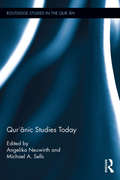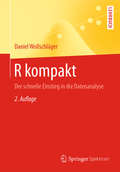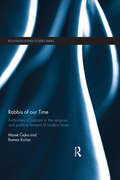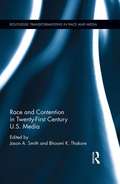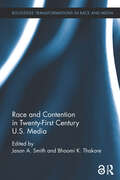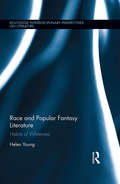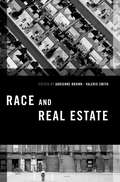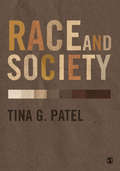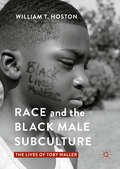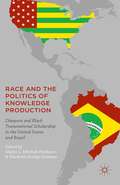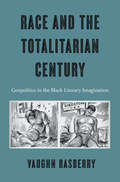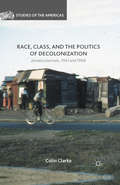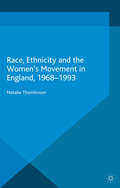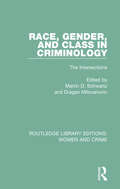- Table View
- List View
The Qur'an in the Malay-Indonesian World: Context and Interpretation (Routledge Studies in the Qur'an)
by Majid Daneshgar Peter G. Riddell Andrew RippinThe largely Arabo-centric approach to the academic study of tafsir has resulted in a lack of literature exploring the diversity of Qur'anic interpretation in other areas of the Muslim-majority world. The essays in The Qur'an in the Malay-Indonesian World resolve this, aiming to expand our knowledge of tafsir and its history in the Malay-Indonesian world. Highlighting the scope of Qur'anic interpretation in the Malay world in its various vernaculars, it also contextualizes this work to reveal its place as part of the wider Islamic world, especially through its connections to the Arab world, and demonstrates the strength of these connections. The volume is divided into three parts written primarily by scholars from Malaysia and Indonesia. Beginning with a historical overview, it then moves into chapters with a more specifically regional focus to conclude with a thematic approach by looking at topics of some controversy in the broader world. Presenting new examinations of an under-researched topic, this book will be of interest to students and scholars of Islamic studies and Southeast Asian studies.
Qur'ānic Studies Today (Routledge Studies in the Qur'an)
by Angelika Neuwirth Michael A. SellsQur'ānic Studies Today brings together specialists in the field of Islamic studies to provide a range of essays that reflect the depth and breadth of scholarship on the Qur'ān. Combining theoretical and methodological clarity with close readings of qur’ānic texts, these contributions provide close analysis of specific passages, themes, and issues within the Qurʾān, even as they attend to the disciplinary challenges within the field of qur’ānic studies today. Chapters are arranged into three parts, treating specific figures appearing in the Qurʾān, analysing particular suras, and finally reflecting on the Qur’ān and its "others." They explore the internal dimensions and interior chronology of the Qur’ān as text, its possible conversations with biblical and non-biblical traditions in Late Antiquity, and its role as scripture in modern exegesis and recitation. Together, they are indispensable for students and scholars who seek an understanding of the Qur’ān founded on the most recent scholarly achievements. Offering both a reflection of and a reflection on the discipline of qur’ānic studies, the strong, scholarly examinations of the Qur’ān in this volume provide a valuable contribution to Islamic and qur’ānic studies.
Qur'ānic Studies Today (Routledge Studies in the Qur'an)
by Angelika Neuwirth Michael A. SellsQur'ānic Studies Today brings together specialists in the field of Islamic studies to provide a range of essays that reflect the depth and breadth of scholarship on the Qur'ān. Combining theoretical and methodological clarity with close readings of qur’ānic texts, these contributions provide close analysis of specific passages, themes, and issues within the Qurʾān, even as they attend to the disciplinary challenges within the field of qur’ānic studies today. Chapters are arranged into three parts, treating specific figures appearing in the Qurʾān, analysing particular suras, and finally reflecting on the Qur’ān and its "others." They explore the internal dimensions and interior chronology of the Qur’ān as text, its possible conversations with biblical and non-biblical traditions in Late Antiquity, and its role as scripture in modern exegesis and recitation. Together, they are indispensable for students and scholars who seek an understanding of the Qur’ān founded on the most recent scholarly achievements. Offering both a reflection of and a reflection on the discipline of qur’ānic studies, the strong, scholarly examinations of the Qur’ān in this volume provide a valuable contribution to Islamic and qur’ānic studies.
R kompakt: Der schnelle Einstieg in die Datenanalyse (Springer-Lehrbuch)
by Daniel WollschlägerDieses Buch liefert eine kompakte Einführung in die Datenauswertung mit der freien Statistikumgebung R. Ziel ist es dabei, einen Überblick über den Basisumfang von R zu schaffen und einen schnellen Einstieg in die deskriptive Datenauswertung sowie in die Umsetzung der wichtigsten statistischen Tests zu ermöglichen. Diese werden an Beispielen erläutert und an vielen Stellen grafisch illustriert. Zudem deckt das Buch die vielfältigen Möglichkeiten ab, Diagramme zu erstellen, Daten mit anderen Programmen auszutauschen und R durch Zusatzpakete zu erweitern. Das Buch ist damit für Leser geeignet, die R kennenlernen und rasch in konkreten Aufgabenstellungen einsetzen möchten.
Rabbinic Judaism: Space and Place (Routledge Jewish Studies Series)
by David KraemerIn the aftermath of the conquest of the Holy Land by the Romans and their destruction of the Jerusalem Temple in 70 CE, Jews were faced with a world in existential chaos—both they and their God were rendered homeless. In a religious tradition that had equated Divine approval with peaceful dwelling on the Land, this situation was intolerable. So the rabbis, aspirants for leadership of the post-destruction Jewish community, appropriated inherited traditions and used them as building blocks for a new religious structure. Not unexpectedly, given the circumstances, this new rabbinic formation devoted considerable attention to matters of space and place. Rabbinic Judaism: Space and Place offers the first comprehensive study of spatiality in Rabbinic Judaism of late antiquity, exploring how the rabbis reoriented the Jewish relationship with space and place following the destruction of the Jerusalem temple. Drawing upon the insights of theorists such as Tuan and LeFebvre, who define the crisis that "homelessness" represents and argue for the deep relationship of human societies to their places, the book examines the compositions of the rabbis and discovers both a surprisingly aggressive rabbinic spatial imagination as well as places, most notably the synagogue, where rabbinic attention to space and place is suppressed or absent. It concludes that these represent two different but simultaneous rabbinic strategies for re-placing God and Israel—strategies that at the same time allow God and Israel to find a place anywhere. This study offers new insight into the centrality of space and place to rabbinic religion after the destruction of the Temple, and as such would be a key resource to students and scholars interested in rabbinic and ancient Judaism, as well as providing a major new case study for anthropologists interested in the study of space.
Rabbinic Judaism: Space and Place (Routledge Jewish Studies Series)
by David KraemerIn the aftermath of the conquest of the Holy Land by the Romans and their destruction of the Jerusalem Temple in 70 CE, Jews were faced with a world in existential chaos—both they and their God were rendered homeless. In a religious tradition that had equated Divine approval with peaceful dwelling on the Land, this situation was intolerable. So the rabbis, aspirants for leadership of the post-destruction Jewish community, appropriated inherited traditions and used them as building blocks for a new religious structure. Not unexpectedly, given the circumstances, this new rabbinic formation devoted considerable attention to matters of space and place. Rabbinic Judaism: Space and Place offers the first comprehensive study of spatiality in Rabbinic Judaism of late antiquity, exploring how the rabbis reoriented the Jewish relationship with space and place following the destruction of the Jerusalem temple. Drawing upon the insights of theorists such as Tuan and LeFebvre, who define the crisis that "homelessness" represents and argue for the deep relationship of human societies to their places, the book examines the compositions of the rabbis and discovers both a surprisingly aggressive rabbinic spatial imagination as well as places, most notably the synagogue, where rabbinic attention to space and place is suppressed or absent. It concludes that these represent two different but simultaneous rabbinic strategies for re-placing God and Israel—strategies that at the same time allow God and Israel to find a place anywhere. This study offers new insight into the centrality of space and place to rabbinic religion after the destruction of the Temple, and as such would be a key resource to students and scholars interested in rabbinic and ancient Judaism, as well as providing a major new case study for anthropologists interested in the study of space.
Rabbis of our Time: Authorities of Judaism in the Religious and Political Ferment of Modern Times (Routledge Jewish Studies Series)
by Marek Čejka Roman KořanThe term ‘rabbi’ predominantly denotes Jewish men qualified to interpret the Torah and apply halacha, or those entrusted with the religious leadership of a Jewish community. However, the role of the rabbi has been understood differently across the Jewish world. While in Israel they control legally powerful rabbinical courts and major religious political parties, in the Jewish communities of the Diaspora this role is often limited by legal regulations of individual countries. However, the significance of past and present rabbis and their religious and political influence endures across the world. Rabbis of Our Time provides a comprehensive overview of the most influential rabbinical authorities of Judaism in the 20th and 21st Century. Through focussing on the most theologically influential rabbis of the contemporary era and examining their political impact, it opens a broader discussion of the relationship between Judaism and politics. It looks at the various centres of current Judaism and Jewish thinking, especially the State of Israel and the USA, as well as locating rabbis in various time periods. Through interviews and extracts from religious texts and books authored by rabbis, readers will discover more about a range of rabbis, from those before the formation of Israel to the most famous Chief Rabbis of Israel, as well as those who did not reach the highest state religious functions, but influenced the relation between Judaism and Israel by other means. The rabbis selected represent all major contemporary streams of Judaism, from ultra-Orthodox/Haredi to Reform and Liberal currents, and together create a broader picture of the scope of contemporary Jewish thinking in a theological and political context. An extensive and detailed source of information on the varieties of Jewish thinking influencing contemporary Judaism and the modern State of Israel, this book is of interest to students and scholars of Jewish Studies, as well as Religion and Politics.
Rabbis of our Time: Authorities of Judaism in the Religious and Political Ferment of Modern Times (Routledge Jewish Studies Series)
by Marek Čejka Roman KořanThe term ‘rabbi’ predominantly denotes Jewish men qualified to interpret the Torah and apply halacha, or those entrusted with the religious leadership of a Jewish community. However, the role of the rabbi has been understood differently across the Jewish world. While in Israel they control legally powerful rabbinical courts and major religious political parties, in the Jewish communities of the Diaspora this role is often limited by legal regulations of individual countries. However, the significance of past and present rabbis and their religious and political influence endures across the world. Rabbis of Our Time provides a comprehensive overview of the most influential rabbinical authorities of Judaism in the 20th and 21st Century. Through focussing on the most theologically influential rabbis of the contemporary era and examining their political impact, it opens a broader discussion of the relationship between Judaism and politics. It looks at the various centres of current Judaism and Jewish thinking, especially the State of Israel and the USA, as well as locating rabbis in various time periods. Through interviews and extracts from religious texts and books authored by rabbis, readers will discover more about a range of rabbis, from those before the formation of Israel to the most famous Chief Rabbis of Israel, as well as those who did not reach the highest state religious functions, but influenced the relation between Judaism and Israel by other means. The rabbis selected represent all major contemporary streams of Judaism, from ultra-Orthodox/Haredi to Reform and Liberal currents, and together create a broader picture of the scope of contemporary Jewish thinking in a theological and political context. An extensive and detailed source of information on the varieties of Jewish thinking influencing contemporary Judaism and the modern State of Israel, this book is of interest to students and scholars of Jewish Studies, as well as Religion and Politics.
Race And Contention In Twenty-first Century U. S. Media (Routledge Transformations In Race And Media Series (PDF))
by Jason A. Smith Bhoomi K. ThakoreThis volume explores and clarifies the complex intersection of race and media in the contemporary United States. Due to the changing dynamics of how racial politics are played out in the contemporary US (as seen with debates of the "post-racial" society), as well as the changing dynamics of the media itself ("new vs. old" media debates), an interrogation of the role of the media and its various institutions within this area of social inquiry is necessary. Contributors contend that race in the United States is dynamic, connected to social, economic, and political structures which are continually altering themselves. The book seeks to highlight the contested space that the media provides for changing dimensions of race, examining the ways that various representations can both hinder or promote positive racial views, considering media in relation to other institutions, and moving beyond thinking of media as a passive and singular institution.
Race and Contention in Twenty-First Century U.S. Media (Routledge Transformations in Race and Media)
by Jason A. Smith Bhoomi K. ThakoreThis volume explores and clarifies the complex intersection of race and media in the contemporary United States. Due to the changing dynamics of how racial politics are played out in the contemporary US (as seen with debates of the "post-racial" society), as well as the changing dynamics of the media itself ("new vs. old" media debates), an interrogation of the role of the media and its various institutions within this area of social inquiry is necessary. Contributors contend that race in the United States is dynamic, connected to social, economic, and political structures which are continually altering themselves. The book seeks to highlight the contested space that the media provides for changing dimensions of race, examining the ways that various representations can both hinder or promote positive racial views, considering media in relation to other institutions, and moving beyond thinking of media as a passive and singular institution.
Race and Contention in Twenty-First Century U.S. Media (Routledge Transformations in Race and Media)
by Jason A. Smith Bhoomi K. ThakoreThis volume explores and clarifies the complex intersection of race and media in the contemporary United States. Due to the changing dynamics of how racial politics are played out in the contemporary US (as seen with debates of the "post-racial" society), as well as the changing dynamics of the media itself ("new vs. old" media debates), an interrogation of the role of the media and its various institutions within this area of social inquiry is necessary. Contributors contend that race in the United States is dynamic, connected to social, economic, and political structures which are continually altering themselves. The book seeks to highlight the contested space that the media provides for changing dimensions of race, examining the ways that various representations can both hinder or promote positive racial views, considering media in relation to other institutions, and moving beyond thinking of media as a passive and singular institution.
Race and Popular Fantasy Literature: Habits of Whiteness (Routledge Interdisciplinary Perspectives on Literature)
by Helen YoungThis book illuminates the racialized nature of twenty-first century Western popular culture by exploring how discourses of race circulate in the Fantasy genre. It examines not only major texts in the genre, but also the impact of franchises, industry, editorial and authorial practices, and fan engagements on race and representation. Approaching Fantasy as a significant element of popular culture, it visits the struggles over race, racism, and white privilege that are enacted within creative works across media and the communities which revolve around them. While scholars of Science Fiction have explored the genre’s racialized constructs of possible futures, this book is the first examination of Fantasy to take up the topic of race in depth. The book’s interdisciplinary approach, drawing on Literary, Cultural, Fan, and Whiteness Studies, offers a cultural history of the anxieties which haunt Western popular culture in a century eager to declare itself post-race. The beginnings of the Fantasy genre’s habits of whiteness in the twentieth century are examined, with an exploration of the continuing impact of older problematic works through franchising, adaptation, and imitation. Young also discusses the major twenty-first century sub-genres which both re-use and subvert Fantasy conventions. The final chapter explores debates and anti-racist praxis in authorial and fan communities. With its multi-pronged approach and innovative methodology, this book is an important and original contribution to studies of race, Fantasy, and twenty-first century popular culture.
Race and Popular Fantasy Literature: Habits of Whiteness (Routledge Interdisciplinary Perspectives on Literature)
by Helen YoungThis book illuminates the racialized nature of twenty-first century Western popular culture by exploring how discourses of race circulate in the Fantasy genre. It examines not only major texts in the genre, but also the impact of franchises, industry, editorial and authorial practices, and fan engagements on race and representation. Approaching Fantasy as a significant element of popular culture, it visits the struggles over race, racism, and white privilege that are enacted within creative works across media and the communities which revolve around them. While scholars of Science Fiction have explored the genre’s racialized constructs of possible futures, this book is the first examination of Fantasy to take up the topic of race in depth. The book’s interdisciplinary approach, drawing on Literary, Cultural, Fan, and Whiteness Studies, offers a cultural history of the anxieties which haunt Western popular culture in a century eager to declare itself post-race. The beginnings of the Fantasy genre’s habits of whiteness in the twentieth century are examined, with an exploration of the continuing impact of older problematic works through franchising, adaptation, and imitation. Young also discusses the major twenty-first century sub-genres which both re-use and subvert Fantasy conventions. The final chapter explores debates and anti-racist praxis in authorial and fan communities. With its multi-pronged approach and innovative methodology, this book is an important and original contribution to studies of race, Fantasy, and twenty-first century popular culture.
RACE AND REAL ESTATE C (Transgressing Boundaries: Studies in Black Politics and Black Communities)
by Valerie Smith Adrienne BrownRace and Real Estate brings together new work by architects, sociologists, legal scholars, and literary critics that qualifies and complicates traditional narratives of race, property, and citizenship in the United States. Rather than simply rehearsing the standard account of how blacks were historically excluded from homeownership, the authors of these essays explore how the raced history of property affects understandings of home and citizenship. While the narrative of race and real estate in America has usually been relayed in terms of institutional subjugation, dispossession, and forced segregation, the essays collected in this volume acknowledge the validity of these histories while presenting new perspectives on this story.
Race and Society (PDF)
by Tina G. PatelRace and Society is a thoughtful and critically engaging exploration of some of the key issues around race and racialisation, which have arisen in what is considered to be a highly diverse and complex society. With a progressive approach emphasising the social construction of race issues within a post-racial era, moving away from essentialist and polarized explanations of raced interaction, Tina Patel: Introduces the main concepts and key theories, including their post-developments. Focuses on the processes and impact of racial categorisation in contemporary society. Highlights the intersectional and multifaceted nature of race and related conceptualizations. Illustrates how race has morphed into newer forms of categorizations. Race and Society is packed with topical examples and international case studies to engage students, along with chapter summaries, study questions and further reading. It's a highly readable and thought-provoking guide to the study of race and racialisation processes for students of sociology, criminology and related disciplines.
Race and the Black Male Subculture: The Lives of Toby Waller
by William T. HostonThis book is a study of black masculinity in the twenty-first century. Through a series of critical and interdisciplinary essays, this work examines the image of the black male in American society as a Toby Waller stereotype. Toby Waller is the fictional, yet symbolic character from Alex Haley’s highly acclaimed book and mini-series, Roots. It is a richly detailed, fictional story about slavery and one enslaved African man’s struggle to regain freedom. The parallel of the life of enslaved Toby Waller is similar to present day black males. Both are individuals who are often stripped of their cultural identity and exist within an institutional and systemic framework that devalues black male life. This dichotomy is the historical platform to discuss how those in the annals of white America demarcate which embodiment merits inclusion into societal acceptance.
Race and the Politics of Knowledge Production: Diaspora and Black Transnational Scholarship in the United States and Brazil
by G. Mitchell-Walthour E. Hordge-FreemanIn this co-edited volume, Gladys L. Mitchell-Walthour and Elizabeth Hordge-Freeman have invited contributors of African descent from the United States and Brazil to reflect on their multidimensional experiences in the field as researchers, collaborators, and allies to communities of color. Contributors promote an interdisciplinary perspective, as they represent the fields of sociology, political science, anthropology, and the humanities. They engage W.E.B. Du Bois' notion of 'second-sight,' which suggests that the unique positionality of Black researchers might provide them with advantages in their empirical observations and knowledge production. They expose the complex and contradictory efforts, discourses, and performances that Black researchers must use to implement and develop their community-centered research agenda. They illustrate that 'second-sight' is not inevitable but must be worked at and is sometimes not achieved in certain research and cultural contexts.
Race and the Totalitarian Century: Geopolitics In The Black Literary Imagination
by Vaughn RasberryVaughn Rasberry turns to black culture and politics for an alternative history of the totalitarian century. He shows how black writers reimagined the standard anti-fascist, anti-communist narrative through the lens of racial injustice, with the U.S. as a tyrannical force in the Third World but also an agent of Asian and African independence.
Race and the Totalitarian Century: Geopolitics In The Black Literary Imagination
by Vaughn RasberryVaughn Rasberry turns to black culture and politics for an alternative history of the totalitarian century. He shows how black writers reimagined the standard anti-fascist, anti-communist narrative through the lens of racial injustice, with the U.S. as a tyrannical force in the Third World but also an agent of Asian and African independence.
Race, Class, and the Politics of Decolonization: Jamaica Journals, 1961 and 1968 (Studies of the Americas)
by Colin ClarkeThis book offers a detailed picture of Jamaica before and after independence. A 1961 journal sheds light on the political and social context before independence, while a 1968 journal shows how independence dissolved dissident forces and identifies the origins of Jamaica's current two party politics.
Race, Ethnicity and the Women's Movement in England, 1968-1993 (Palgrave Studies in the History of Social Movements)
by Natalie ThomlinsonThis book is the first archive-based account of the charged debates around race in the women's movement in England during the 'second wave' period. Examining both the white and the Black women's movement through a source base that includes original oral histories and extensive research using feminist periodicals, this book seeks to unpack the historical roots of long-running tensions between Black and white feminists. It gives a broad overview of the activism that both Black and white women were involved in, and examines the Black feminist critique of white feminists as racist, how white feminists reacted to this critique, and asks why the women's movement was so unable to engage with the concerns of Black women. Through doing so, the book speaks to many present day concerns within the women's movement about the politics of race, and indeed the place of identity politics within the left more broadly.
Race, Gender, and Class in Criminology: The Intersections (Routledge Library Editions: Women and Crime)
by Dragan Milovanovic Martin D. SchwartzThese essays, first published in 1996, focus on class, race, and gender as organising and analytical concepts in criminology. For many years, their importance in studying how the world relates to crime and its control was minimized or ignored. It is clear, however, that these concepts are of critical importance in understanding societal issues, especially crime and societal responses to it. This title will be of interest to students of criminology.
Race, Gender, and Class in Criminology: The Intersections (Routledge Library Editions: Women and Crime #4)
by Martin D. Schwartz Dragan MilovanovicThese essays, first published in 1996, focus on class, race, and gender as organising and analytical concepts in criminology. For many years, their importance in studying how the world relates to crime and its control was minimized or ignored. It is clear, however, that these concepts are of critical importance in understanding societal issues, especially crime and societal responses to it. This title will be of interest to students of criminology.
Race, Gender, Sexuality, and Social Class: Dimensions of Inequality and Identity (Second Edition) (PDF)
by Susan FergusonAn eye-opening exploration of how socials statuses intersect to shape our identities and produce inequalities. In this fully edited and streamlined Race, Gender, Sexuality, and Social Class: Dimensions of Inequality and Identity, Second Edition, Susan Ferguson has carefully selected readings that open readers’ eyes to the ways that social statuses shape our experiences and impact our life chances. The anthology represents many of the leading voices in the field and reflects the many approaches used by scholars and researchers to understand this important and evolving subject. The anthology is organized around broad topics (Identity, Power and Privilege, Social Institutions, etc.), rather than categories of difference (Race, Gender, Class, Sexuality) to underscore this fundamental insight: race, class, gender, and sexuality do not exist in isolation; they often intersect with one another to produce social inequalities and form the bases of our identities in society.
Race policy and multiracial Americans
by Kathleen Odell KorgenRace Policy and Multiracial Americans is the first book to look at the impact of multiracial people on race policies—where they lag behind the growing numbers of multiracial people in the U.S. and how they can be used to promote racial justice for multiracial Americans. Using a critical mixed race perspective, it covers such questions as: Which policies aimed at combating racial discrimination should cover multiracial Americans? Should all (or some) multiracial Americans benefit from affirmative action programmes? How can we better understand the education and health needs of multiracial Americans?This much-needed book is essential reading for sociology, political science and public policy students, policy makers, and anyone interested in race relations and social justice.

